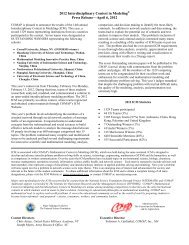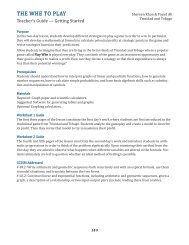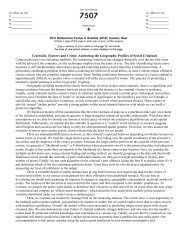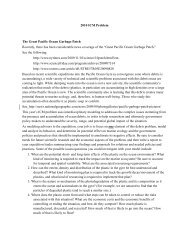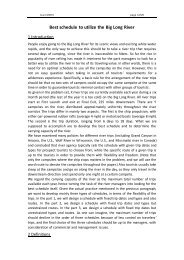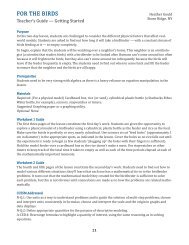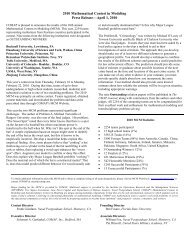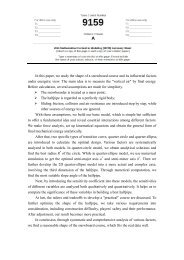Team 13955: Computing Along the Big Long River
Team 13955: Computing Along the Big Long River
Team 13955: Computing Along the Big Long River
You also want an ePaper? Increase the reach of your titles
YUMPU automatically turns print PDFs into web optimized ePapers that Google loves.
Page 12 of 18 Control #<strong>13955</strong><br />
4 Case Study<br />
4.1 The Grand Canyon<br />
The Grand Canyon is an ideal case study for our model. It shares many characteristics with <strong>the</strong><br />
<strong>Big</strong> <strong>Long</strong> <strong>River</strong>. The Canyon’s primary river rafting stretch is 226 miles, has 235 campsites and is open<br />
approximately six months out of <strong>the</strong> year. It allows tourists to travel by motorized boat, or oar powered<br />
river raft for a maximum of 12 or 18 days respectively [3].<br />
Using <strong>the</strong> parameters of <strong>the</strong> Grand Canyon, we tested our model by running a number of<br />
simulations. We altered <strong>the</strong> number of groups we were placing on <strong>the</strong> water each day, attempting to<br />
find a maximum “carrying capacity” for <strong>the</strong> river. We define “carrying capacity” as <strong>the</strong> maximum<br />
number of possible trips down <strong>the</strong> Canyon’s river over a six month season. This is subject to <strong>the</strong><br />
constraint that each trip must end according to a group’s trip duration.<br />
During its summer season, <strong>the</strong> Grand Canyon typically places six new groups on <strong>the</strong> water each<br />
day [3], so we use this value for our first simulation. In each of <strong>the</strong> follow simulations we used an equal<br />
distribution of motorized boats to oar powered river rafts, along with an equal distribution of trip<br />
lengths.<br />
Our model predicts <strong>the</strong> number of groups that make it off <strong>the</strong> end of <strong>the</strong> river (completed trips),<br />
how many of those trips arrive past <strong>the</strong>ir desired end date (late trips), and <strong>the</strong> number of groups which<br />
did not make it off <strong>the</strong> waitlist (total left on waitlist). These values change as we vary <strong>the</strong> number of<br />
new groups placed on <strong>the</strong> water each day (groups/day).<br />
Simulation # Groups/day Completed<br />
trips.<br />
Late Trips Total left on<br />
waitlist<br />
1 6 996 0 0<br />
2 8 1328 0 0<br />
3 10 1660 0 0<br />
4 12 1992 0 0<br />
5 14 2324 0 0<br />
6 16 2656 0 0<br />
7 17 2834 0 0<br />
8 18 2988 0 0<br />
9 19 3154 5 0<br />
10 20 3248 10 43<br />
11 21 3306 14 109<br />
Figure 4.1: We predict that a maximum of 18 groups can be sent down <strong>the</strong> river each day. Over <strong>the</strong><br />
course of <strong>the</strong> six month season, this amounts to nearly 3000 trips.<br />
We conclude that <strong>the</strong> maximum carrying capacity of <strong>the</strong> Grand Canyon is around 3000, and is<br />
achieved by sending 18 new groups down <strong>the</strong> river each day. Increasing groups/day above 18 is likely<br />
to cause late trips and long waitlists.<br />
Notice that some groups are still on <strong>the</strong> river when our simulation ends. In simulation # 1, we<br />
send a total of 1080 groups down that river (6 groups/day×180 days), but only 996 groups make it off.<br />
This is simply because groups which began towards <strong>the</strong> end of <strong>the</strong> six month period have not reached<br />
<strong>the</strong> end of <strong>the</strong>ir trip, so <strong>the</strong> groups are still on <strong>the</strong> river. These groups have negligible impact on our<br />
simulation and <strong>the</strong>y are essentially ignored.







